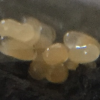Founding queens have to deal with limited resources, especially protein.
What would happen if a founding queen would lay 200 eggs? The eggs will develop into larvae. In order to grow larvae require protein. But a founding queen only has a limited amount of it available so there is no way she would be able to feed all of them sufficiently with protein to become workers. So in the worst case, all larvae might dye and then the queen after some time too.
That's why queen limits the number of eggs they lay after nuptial flight.
The number of eggs laid will increase with colony size, until it finally reaches the maximum a queen is able to produce in a specific time or it is limited by protein available to the colony in its foraging zone.

















